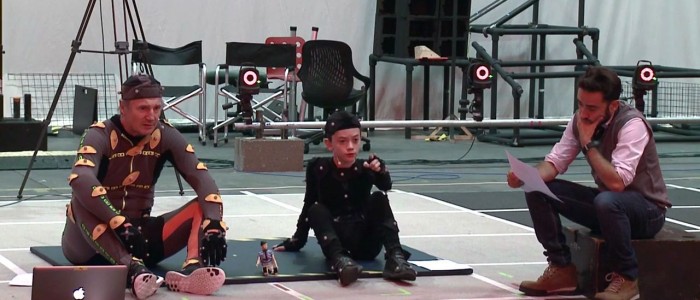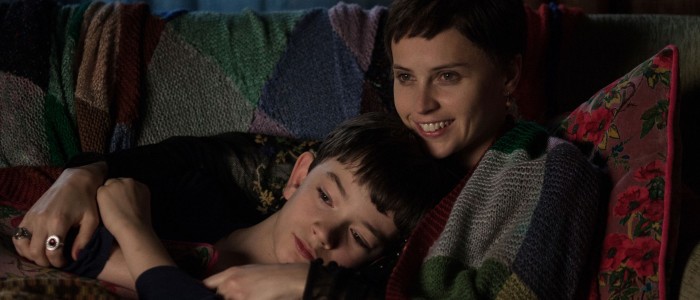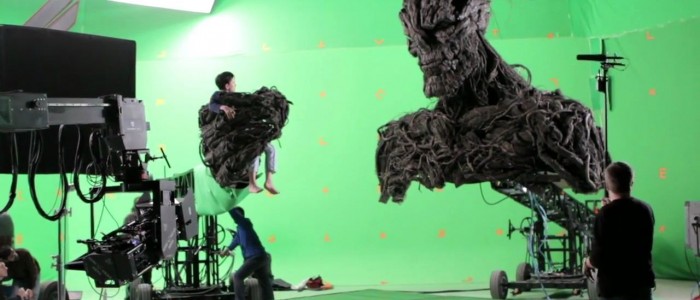Interview: Director J.A. Bayona On Exploring Destruction And Storytelling 'In A Monster Calls'
J.A. Bayona's latest film packs a heavy punch. Bayona's adaptation of author and screenwriter Patrick Ness' novel is a pure tearjerker, a movie that mixes the grand with the intimate. The film follows a young boy (Lewis MacDougall) struggling with his mother's terminal illness. In need of help, he calls upon a monster (Liam Neeson), a talking tree that promises to tell Conor three stories as long as the boy reveals his deepest, darkest secret.A Monster Calls deals heavily with the power of storytelling. After making only three films, Bayona has established himself as a very emotional storyteller. "Cold" is not a word that applies to the visual splendor of his work. We recently interviewed the filmmaker for his latest drama, which was originally based on an idea by the late author, Siobhan Dowd. Bayona discussed with us the music on set, King Kong, the silent moments in A Monster Calls, and his reaction to seeing Jurassic Park for the first time.
Below, read our J.A. Bayona interview.
What was your initial reaction to the book?
Surprise because it had a lot of ideas in common with my other films. Of course, it's a very emotional story, so you get a very immediate impression of how emotional this film could be. But what I thought was very interesting was this idea of exploring the storytelling and finding the truth, and express the truth, which is basically what you do as a filmmaker. You get to the set every day, and you try to get the truth out of your actors and put it on the screen in the best way possible.
What were some of the ideas that made you think of your past films?
I think the few films I've done so far are about how we relate to fantasy. Even The Impossible was based on a real story, and for me, it's a story that is a thought on how we live a fantasy as westerners living in a western world, going to Thailand and suddenly going through the experience of a tsunami and discovering what reality is about. That's somehow a way of putting the characters in between a world of reality and fantasy, and how going back to that fantasy world that is living in the luxuries of the first world is something painful for them. It's, again, how you get in contact with the uncertainty and how you put the worlds of fantasy and reality collapsing, in between them.
What were some of the novel's key elements you wanted to remain faithful to?
From the very first moment, I wanted to be faithful to the book, but I also had the impression that I wanted to find some light at the end of the story. Somehow, I felt that I had to find light at the end of the journey of Conor. I told that my very first meeting to Patrick Ness that I wanted to find that and then I came with this idea that Conor is an artist and somehow his connection to art puts him in contact with the other characters and makes the whole interpretation of the story a little different. You have the last scene of the story in the film that it's not in the book, that it's all about somehow through art he can connect his past with his future, and you can see hope in there.
 How did Jim Kay's illustrations [from the book] influence you?
How did Jim Kay's illustrations [from the book] influence you?
I remember the first time I read the book it was an illustrated book, so it was impossible when I started to think about the film to separate the story of Patrick Ness from the drawings of Jim Kay. From the very first moment, I had to think about how I was going to put the stories on the screen, how I was going to visualize the stories. The drawings came to my mind because I normally don't like movies where you can see stories inside a story, and you see other actors playing stories into a story that has its own actors. I always find it very distracting, so I thought animation is the best way to explain that. Then I thought about the drawings of the book, and then I had this idea that I wanted Conor to be an artist because I was obsessed with drawing when I was a kid, too. It was a way of finding something very personal to me.
After you read the book, were there any shots you immediately imagined?
I wanted to put, I remember, a shot of a drawing of King Kong on the wall, and on the wall, you can see the shadow of the rain projected. It's like seeing King Kong crying. I thought it was a beautiful way of showing the monster crying in my film. That was one of the images I was obsessed with putting in the film from the very beginning, and it's in the film.
Is King Kong an important film for you?
I remember that when I was very little at school, they used to project every year King Kong at the end of the year. What I thought was very interesting about King Kong is that when you see the film as a kid, you are with King Kong. King Kong is supposed to be the bad guy in the story, and the good guys are the ones who killed King Kong. Then you start as a kid finding it very contradictory that they're killing King Kong, but you like King Kong. I thought that somehow that reflected the confusion that Conor is going through. He likes King Kong, but they're killing King Kong. Of course, when he sees King Kong falling from the Empire State, that image resonates with him because that image reminds him his own nightmare.
I think a lot of movie fans can relate to that experience — seeing an emotion in a film you maybe don't fully understand when you're a kid, but it still resonates.
Of course. Dealing with emotions that you cannot control yet. That's the idea of destruction. We, as kids, we love destruction. Especially movies with giant people, they deal a lot with destruction. We're seeking the Godzilla, and we love to see Japan being destroyed by Godzilla. As a kid, destruction is a very fascinating idea and, at the same time, it's a way of dealing with your own frustration of not knowing how to deal with some emotions.
 For scenes where there's no destruction, like when Conor is talking to his dad, what sort of atmosphere do you want to create on set?
For scenes where there's no destruction, like when Conor is talking to his dad, what sort of atmosphere do you want to create on set?
There is some talking. Also, it's good to work the atmosphere on the set. It's like everyone should be aware we're doing an important moment. I shoot with a lot of music all the time, so depending on how the music is on the set, the whole crew now knows what is the mood of the scene we're doing. When you play music on the set, it's good for the actors. It's good for the crew, and it's fun. When you play music, and you get the performance the same time music is on the set, you can see the whole crew haunted by what they're seeing. Everyone is very focused on what's in front of the camera.
What music did you play?
It depends. There are moments in the film I'm dealing with destruction I was playing Godzilla music. There were emotional moments I was playing [Ennio] Morricone. It's funny because some of the moments we were using music, then we don't use music in the film. I think one of the things I'm most proud of is the most emotional scenes of the film; they play more with silence than with music. It's all about the performance of the actors.
How do you typically like to work with younger actors? Do you provide them a sense of freedom or structure?
The other day I was with Tom Holland, and he was telling me that one of the things he appreciated in The Impossible is that I was treating him exactly the same way I deal with actors in the film. It's true. At the end, you need to get a performance. They need to wake up every day at 5:00 in the morning. They need to do exactly the same things as the other people do, so you treat them exactly like the other ones. But, at the same time, they're kids, and they don't understand what they're doing. The kind of work that you need to do is not only about the performance but also about to make them understand what they're doing and somehow help them in dealing with the experience in shooting a film.
When I did Impossible, it was Tom Holland's first film and you have all the time this feeling, this impression, that you need to help them to cope not only with the film but with the experience they're going to have once they finish the film, and make them understand that making a film is a unique thing that is not everyday life, that doesn't represent everyday life, and somehow you feel like a mentor, that you tried to get the performance, but at the same time, you have the impression that you need to take care of them.
What was the casting process like for Conor?
It was very interesting in the audition that Lewis MacDougall did because we were playing some of the most dramatical stuff in the auditions, and most of the kids, all the kids, they went for the tears. They went very emotional, but Lewis didn't go for that. He was more about rage, and I felt that was so unique. Suddenly, I have this kid that didn't want to cry, that was angry for what he was going through, and I felt that there was so much truth in there that I knew from the very first time that I work with him that he was a unique boy. At the end, we had a bunch of five kids, and he was still the best. It was so obvious that he had to do the film.
 I just saw this great behind the scenes photo of the Monster. It looks like you relied on a lot of practical effects.
I just saw this great behind the scenes photo of the Monster. It looks like you relied on a lot of practical effects.
First of all, it was very important to keep the story grounded, so the fantasy had to be very grounded. From the moment you see King Kong, it's a statement, the old King Kong, because we wanted to do the special effects the same way they did it. We recreated the whole arm. We recreated the head, one foot, and the scenes that we couldn't do with real stuff, we were using CGI the same way they were using stop-motion. It was a combination of CGI with real stuff and all the CGI, all the textures were taken from the real section so the monster that we did. That was the intention of keeping the film somehow grounded. The fantasy of the story is grounded.
I'm sure you saw a lot of different designs early on for the monster. What different iterations did the character go through?
I think the more design was the creature, the less space was for the imagination of the audience. I remember there was an illustration in the book where you can see the monster sitting down on a rooftop and it felt so powerful that I thought that the more we were adding to that design, the less effective the creature was. I thought that at the end it had to be a very simple design. I think that's what makes the whole thing much more effective.
How about the animated sequences? How did you want them to help drive the story?
I think the animation, it has its own way of progressing. It starts being like watercolor animations and then turns into something that feels more like stop-motion. The third tale happens in reality, so it was like a way of making the animation more and more real as it goes. In that journey, there is a moment that the character is getting to the animation. You can see the characters into the animation, and we did a lot of research in trying to make that look good. We didn't want to have the look of Mary Poppins. We explored a lot to find the look that what we're looking for, where you can see these watercolor skies, and with this monster that looks different from the real monster with Conor.
My last question for you: What was your reaction to seeing Jurassic Park for the first time?
The first time I saw the dinosaur, the first Brachiosaurus, I realized that everything can be done. From now on, everything can be done. That was like a pivotal moment not just in visual effects, but in fantasy films. From that moment on, everything changed.
***
A Monster Calls is now in theaters.
